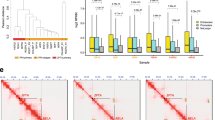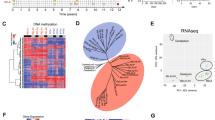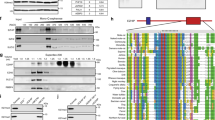Abstract
Ependymomas are common childhood brain tumours that occur throughout the nervous system, but are most common in the paediatric hindbrain. Current standard therapy comprises surgery and radiation, but not cytotoxic chemotherapy as it does not further increase survival. Whole-genome and whole-exome sequencing of 47 hindbrain ependymomas reveals an extremely low mutation rate, and zero significant recurrent somatic single nucleotide variants. Although devoid of recurrent single nucleotide variants and focal copy number aberrations, poor-prognosis hindbrain ependymomas exhibit a CpG island methylator phenotype. Transcriptional silencing driven by CpG methylation converges exclusively on targets of the Polycomb repressive complex 2 which represses expression of differentiation genes through trimethylation of H3K27. CpG island methylator phenotype-positive hindbrain ependymomas are responsive to clinical drugs that target either DNA or H3K27 methylation both in vitro and in vivo. We conclude that epigenetic modifiers are the first rational therapeutic candidates for this deadly malignancy, which is epigenetically deregulated but genetically bland.
This is a preview of subscription content, access via your institution
Access options
Subscribe to this journal
Receive 51 print issues and online access
$199.00 per year
only $3.90 per issue
Buy this article
- Purchase on Springer Link
- Instant access to full article PDF
Prices may be subject to local taxes which are calculated during checkout





Similar content being viewed by others
Accession codes
Accessions
Gene Expression Omnibus
Data deposits
Illumina 450K CpG Methylation array data, NimbleGen 385K CpG Island Plus array data, and ChIP-seq data have been deposited at the Gene Expression Omnibus (GEO: http://www.ncbi.nlm.nih.gov/geo/) as a GEO super-series under the accession number GSE43353. Whole-genome and whole-exome sequencing data have been deposited in the European Genome-Phenome Archive (EGA: https://www.ebi.ac.uk/ega/) hosted by the EBI, under the accession number EGAS00001000443.
References
Taylor, M. D. et al. Radial glia cells are candidate stem cells of ependymoma. Cancer Cell 8, 323–335 (2005)
Merchant, T. E. et al. Conformal radiotherapy after surgery for paediatric ependymoma: a prospective study. Lancet Oncol. 10, 258–266 (2009)
Bouffet, E. & Foreman, N. Chemotherapy for intracranial ependymomas. Childs Nerv. Syst. 15, 563–570 (1999)
Bouffet, E. et al. Survival benefit for pediatric patients with recurrent ependymoma treated with reirradiation. Int. J. Radiat. Oncol. Biol. Phys. 83, 1541–1548 (2012)
Johnson, R. A. et al. Cross-species genomics matches driver mutations and cell compartments to model ependymoma. Nature 466, 632–636 (2010)
Witt, H. et al. Delineation of two clinically and molecularly distinct subgroups of posterior fossa ependymoma. Cancer Cell 20, 143–157 (2011)
Wani, K. et al. A prognostic gene expression signature in infratentorial ependymoma. Acta Neuropathol. 123, 727–738 (2012)
Atkinson, J. M. et al. An integrated in vitro and in vivo high-throughput screen identifies treatment leads for ependymoma. Cancer Cell 20, 384–399 (2011)
Jones, D. T. et al. Dissecting the genomic complexity underlying medulloblastoma. Nature 488, 100–105 (2012)
Lawrence, M. S. et al. Mutational heterogeneity in cancer and the search for new cancer-associated genes. Nature 499, 214–218 (2013)
Dees, N. D. et al. MuSiC: identifying mutational significance in cancer genomes. Genome Res. 22, 1589–1598 (2012)
Brennan, C. W. et al. The somatic genomic landscape of glioblastoma. Cell 155, 462–477 (2013)
Koboldt, D. C. et al. Comprehensive molecular portraits of human breast tumours. Nature 490, 61–70 (2012)
Muzny, D. M. et al. Comprehensive molecular characterization of human colon and rectal cancer. Nature 487, 330–337 (2012)
Peifer, M. et al. Integrative genomic analyses identify key somatic driver mutations of small-cell lung cancer. Nature Genetics 44, 1104–1110 (2012)
Zhang, J. et al. The genetic basis of early T-cell precursor acute lymphoblastic leukaemia. Nature 481, 157–163 (2012)
Hammerman, P. S. et al. Comprehensive genomic characterization of squamous cell lung cancers. Nature 489, 519–525 (2012)
Hodis, E. et al. A landscape of driver mutations in melanoma. Cell 150, 251–263 (2012)
Chapman, M. A. et al. Initial genome sequencing and analysis of multiple myeloma. Nature 471, 467–472 (2011)
Imielinski, M. et al. Mapping the hallmarks of lung adenocarcinoma with massively parallel sequencing. Cell 150, 1107–1120 (2012)
Bell, D. et al. Integrated genomic analyses of ovarian carcinoma. Nature 474, 609–615 (2011)
Pugh, T. J. et al. The genetic landscape of high-risk neuroblastoma. Nature Genetics 45, 279–284 (2013)
Berger, M. F. et al. The genomic complexity of primary human prostate cancer. Nature 470, 214–220 (2011)
Lee, R. S. et al. A remarkably simple genome underlies highly malignant pediatric rhabdoid cancers. J. Clin. Invest. 122, 2983–2988 (2012)
Zhang, J. et al. A novel retinoblastoma therapy from genomic and epigenetic analyses. Nature 481, 329–334 (2012)
Northcott, P. A. et al. Subgroup-specific structural variation across 1,000 medulloblastoma genomes. Nature 488, 49–56 (2012)
Pugh, T. J. et al. Medulloblastoma exome sequencing uncovers subtype-specific somatic mutations. Nature 488, 106–110 (2012)
Robinson, G. et al. Novel mutations target distinct subgroups of medulloblastoma. Nature 488, 43–48 (2012)
Schwartzentruber, J. et al. Driver mutations in histone H3.3 and chromatin remodelling genes in paediatric glioblastoma. Nature 482, 226–231 (2012)
Sausen, M. et al. Integrated genomic analyses identify ARID1A and ARID1B alterations in the childhood cancer neuroblastoma. Nature Genet. 45, 12–17 (2013)
Wu, G. et al. Somatic histone H3 alterations in pediatric diffuse intrinsic pontine gliomas and non-brainstem glioblastomas. Nature Genet. 44, 251–253 (2012)
Versteege, I. et al. Truncating mutations of hSNF5/INI1 in aggressive paediatric cancer. Nature 394, 203–206 (1998)
Northcott, P. A. et al. Multiple recurrent genetic events converge on control of histone lysine methylation in medulloblastoma. Nature Genet. 41, 465–472 (2009)
Noushmehr, H. et al. Identification of a CpG island methylator phenotype that defines a distinct subgroup of glioma. Cancer Cell 17, 510–522 (2010)
Ohm, J. E. et al. A stem cell-like chromatin pattern may predispose tumor suppressor genes to DNA hypermethylation and heritable silencing. Nature Genet. 39, 237–242 (2007)
Kantarjian, H. et al. Decitabine improves patient outcomes in myelodysplastic syndromes: results of a phase III randomized study. Cancer 106, 1794–1803 (2006)
Tan, J. et al. Pharmacologic disruption of Polycomb-repressive complex 2-mediated gene repression selectively induces apoptosis in cancer cells. Genes Dev. 21, 1050–1063 (2007)
McCabe, M. T. et al. EZH2 inhibition as a therapeutic strategy for lymphoma with EZH2-activating mutations. Nature 492, 108–112 (2012)
Turcan, S. et al. IDH1 mutation is sufficient to establish the glioma hypermethylator phenotype. Nature 483, 479–483 (2012)
Williams, K. et al. TET1 and hydroxymethylcytosine in transcription and DNA methylation fidelity. Nature 473, 343–348 (2011)
Fang, F. et al. Breast cancer methylomes establish an epigenomic foundation for metastasis. Sci. Transl. Med. 3, 75ra25 (2011)
Roman-Gomez, J. et al. Lack of CpG island methylator phenotype defines a clinical subtype of T-cell acute lymphoblastic leukemia associated with good prognosis. J. Clin. Oncol. 23, 7043–7049 (2005)
Zouridis, H. et al. Methylation subtypes and large-scale epigenetic alterations in gastric cancer. Sci. Transl. Med. 4, 156ra140 (2012)
Toyota, M. et al. CpG island methylator phenotype in colorectal cancer. Proc. Natl Acad. Sci. USA 96, 8681–8686 (1999)
Weisenberger, D. J. et al. CpG island methylator phenotype underlies sporadic microsatellite instability and is tightly associated with BRAF mutation in colorectal cancer. Nature Genet. 38, 787–793 (2006)
Ben-Porath, I. et al. An embryonic stem cell-like gene expression signature in poorly differentiated aggressive human tumors. Nature Genet. 40, 499–507 (2008)
Down, T. A. et al. A Bayesian deconvolution strategy for immunoprecipitation-based DNA methylome analysis. Nature Biotechnol. 26, 779–785 (2008)
Lupien, M. et al. FoxA1 translates epigenetic signatures into enhancer-driven lineage-specific transcription. Cell 132, 958–970 (2008)
Hansen, K. D. et al. Increased methylation variation in epigenetic domains across cancer types. Nature Genet. 43, 768–775 (2011)
Gallo, M. et al. A tumorigenic MLL-homeobox network in human glioblastoma stem cells. Cancer Res. 73, 417–427 (2013)
Acknowledgements
M.D.T. holds a Canadian Institutes of Health Research (CIHR) Clinician-Scientist Phase II Award, was a Sontag Foundation Distinguished Scholar, and is supported by The Garron Family Chair in Childhood Cancer Research. M.D.T. is supported by grants from the Cure Search Foundation, The Younger Foundation, the National Institutes of Health (R01CA148699 and R01CA159859), The Pediatric Brain Tumor Foundation, The Canadian Cancer Society, The Terry Fox Research Institute, and Brainchild. S.M., K.M.W. and A.D. are supported by Vanier Scholarships from CIHR. S.M. would like to thank K. Mack, R. Mack, S. Mack and K. Bertrand for their support of this project. This study was conducted with the support of the Ontario Institute for Cancer Research through funding provided by the Government of Ontario. This work was also supported by a Program Project Grant from the Terry Fox Research Institute, and a Grand Challenge Award from CureSearch for Children’s Cancer. Additionally, this work was supported by the PedBrain Tumor Project contributing to the International Cancer Genome Consortium, funded by German Cancer Aid (109252) and by the German Federal Ministry of Education and Research (BMBF, grants 01KU1201A, MedSys 0315416C and NGFNplus 01GS0883). This study was supported by grants from the Sander Foundation and DKTK (Molecular Diagnostics of Pediatric Malignancies). For technical support and expertise of next-generation sequencing efforts we thank the DKFZ Genomics and Proteomics Core Facility, The EMBL Genomics Core Facility, and The Centre for Applied Genomics (Toronto). We thank S. Archer for technical writing and C. Smith for artwork. We thank A. Wittmann, L. Sieber and L. Linke for clinical assistance.
Author information
Authors and Affiliations
Contributions
S.C.M., H.W., M.D.T., A.K. and S.M.P. conceived and led the study. S.C.M. performed sample preparation, data acquisition and bioinformatic analysis related to DNA methylation, ChIP-seq and transcriptional profiling experiments. S.C.M. also performed western blot analysis and contributed to in vitro and in vivo experiments. H.W. led whole-genome sequencing, whole-exome sequencing and whole-genome bisulphite sequencing efforts, with analytical support from R.M.P., L. Gu., N. Jäger, D.T.W.J., S.S., S.H., T.Z., A.M.S., T.J.P., M.S., H.S.-C., T.T., V.H. and J.O.K. S.Z. and G.D.B. developed and applied pathway analysis methods for all data sets in this study. K.N.-B., M.G., L. Garzia, K.Z., X. Wang, M.B., S.B., P.J., X. Wu, K.C.B., T.M., J.Z., P.S.-C., C.C.F., P.C.-B., Y.Y. and S.A. performed in vitro, in vivo and molecular/biochemical experiments central to the project. DNA methylation and ChIP-seq bioinformatic analysis and experimental design were supported by X.Z., V.R., P.N.K., A.M.D., P.A.N., D.J.H.S., J.P., M. Remke, F.M.G.C., L.L., S.P., S.W.S., S.D.B., M.G., J.K., I.C., R.H. and P.B.D., developed and characterized ependymoma primary cultures, and assisted with in vitro and in vivo experiments. C.L.C. and S.K.V. developed the EZH2 compounds and provided inhibitors for experimentation. S.S.R., L.M., Y.J.C., T.V.M., W.G., B.L., M. Ryzhova, A.K., N.G., J.P., K.W. and K.D.A. provided patient samples and clinical details that made this study possible. M.H., M.A.M., M.L., D.F., A.E.K., A.v.D., O.W., D.M., X.F., K.M.M., M.K., S.L.P., E.B., W.A.W., A.H., U.T., C.H., J.T.R., N. Jabado, J.O.K., R.E., P.L., G.D.B., K.D.A., P.B.D. and S.M.P. provided valuable input regarding study design, data analysis and interpretation of results. M.D.T., S.C.M., H.W., A.K. and S.M.P. wrote the manuscript. M.D.T. and S.M.P. provided financial and technical infrastructure and oversaw the study. M.D.T. and A.K. are joint senior authors and project co-leaders.
Corresponding authors
Ethics declarations
Competing interests
The authors declare no competing financial interests.
Supplementary information
Supplementary Figures
This file contains Supplementary Figures 1-18. (PDF 9722 kb)
Supplementary Tables
This file contains Supplementary Tables 1-23. (XLSX 30536 kb)
Rights and permissions
About this article
Cite this article
Mack, S., Witt, H., Piro, R. et al. Epigenomic alterations define lethal CIMP-positive ependymomas of infancy. Nature 506, 445–450 (2014). https://doi.org/10.1038/nature13108
Received:
Accepted:
Published:
Issue Date:
DOI: https://doi.org/10.1038/nature13108
This article is cited by
-
Common molecular features of H3K27M DMGs and PFA ependymomas map to hindbrain developmental pathways
Acta Neuropathologica Communications (2023)
-
Methylation across the central dogma in health and diseases: new therapeutic strategies
Signal Transduction and Targeted Therapy (2023)
-
“Soap bubble” sign as an imaging marker for posterior fossa ependymoma Group B
Neuroradiology (2023)
-
3D genome mapping identifies subgroup-specific chromosome conformations and tumor-dependency genes in ependymoma
Nature Communications (2023)
-
Redefining germline predisposition in children with molecularly characterized ependymoma: a population-based 20-year cohort
Acta Neuropathologica Communications (2022)
Comments
By submitting a comment you agree to abide by our Terms and Community Guidelines. If you find something abusive or that does not comply with our terms or guidelines please flag it as inappropriate.



